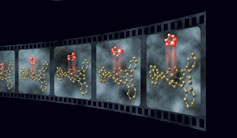

Monday - August 14, 2006
SLAC Today is
available online at:
http://today.slac.stanford.edu
In this issue:
LCLS: The Machine & the Science
Dorfan Today: 2006 — A Bumper Year for SPEAR3
Profile: Protein Crystallography Pioneer Paul Phizackerley
 |
 |
|
Monday - August 14, 2006 |
WIS Seminar — LCLS: The Machine & the Science
The LCLS will be able to capture the processes of chemical reactions "frame
by frame" to see for the first time how molecules make and break chemical
bonds. SLAC faces an exciting transition period in the next few years as the Linac Coherent Light Source (LCLS) takes shape at the lab. Construction has already begun with the demolition of several buildings in the research yard, and tunneling will begin this Fall. If all goes according to plan, the machine will see first light in 2008. To help explain the LCLS and the research it will undertake, the Women's Interchange at SLAC (WIS) is proud to present "LCLS: The Machine and the Science" tomorrow afternoon at 12 p.m. in the Panofsky Auditorium. The lecture will be presented by SLAC's Cecile Limborg and Western Michigan University's Nora Berrah. Limborg, who has been working on the design of the LCLS Injector since 2000 and is now responsible for the injector's beam quality, will describe the LCLS machine in terms understandable to the non-scientist. Berrah, whose current research interests are in the experimental investigation of the electronic structure and dynamics in atoms, molecules, clusters, and their ions, will describe past and future experiments in photon science, also at a simple level. Learn more... |
||
|
|
||
 2006: A Bumper Year for SPEAR3Late Friday afternoon I joined a happy and relaxed group of SSRL staff, their families and some SPEAR3 users for their annual end of run party. FY2006 has been a bumper year for our SPEAR3 facility and there was much to celebrate. Since the commissioning of SPEAR3 in 2004, we have seen amazing advances in the operational ability of the storage ring and beamlines that have translated into much improved experimental performance for the users. And during the three-month SPEAR3 shutdown that began on August 7, we will see even more improvements and upgrades, many of which will be key to bringing us closer to operating at 500 milliamps of stored current and, in addition, employing the top-off injection mode that was pioneered so successfully by among others the PEP-II team. During the 2006 run, SPEAR3 operators delivered an exceptional degree of beam reliability to users with an uptime of 96.2 percent. About 1,000 experiments were conducted on 20 beamlines by approximately 900 users, many of whom performed their research from off-site using remote access. Overall, users are providing very positive feedback about their experiences at SSRL.
A large number of these users go on to publish their results—a sustained average of 400 journal publications a year—and in 2006, SPEAR3 continued producing even more world-class science, including several notably spectacular successes. |
Protein Crystallography Pioneer Phizackerley
"We spent a lot of nights just sleeping on the floor," he said, his accent still undeniably British despite living in the States for 34 years. "Such diverse talented people work here, and they're great company, which is important when you're doing experiments night and day." Phizackerley has seen and created many changes at SSRL in his 28 years at SLAC. He collaborated with Keith Hodgson, Photon Science Director, to develop what is now a primary means of revealing protein structures. He also pushed for using robotics to make protein crystallography experiments more efficient. Now users can send their crystallized samples by overnight mail to the lab and remotely conduct their experiments. (See related SLAC Today article.) In 2002, Phizackerley was honored with the Farrel Lytle Award. The award citation reads: His very nature embodies the spirit of free exchange of scientific ideas, and his approach consistently promotes the greater good within the community. "When I first started in the field, it could take years to solve a single protein structure. Now we can solve one in a few hours. It's just been remarkable what high brightness synchrotron radiation plus new techniques and methodologies have given us," Phizackerley said. Recently retired, the emeritus professor still visits the lab almost daily. |
Events (see all | submit)
Access (see all)Announcements
|
| | ||
|
|
||
 <%
Response.AddHeader "Last-modified", getArticleDate()
'Response.AddHeader "Last-modified","Mon, 01 Sep 1997 01:03:33 GMT"
'Monday, December 06, 2010
%>
<%
Response.AddHeader "Last-modified", getArticleDate()
'Response.AddHeader "Last-modified","Mon, 01 Sep 1997 01:03:33 GMT"
'Monday, December 06, 2010
%>View online at http://today.slac.stanford.edu//. |
||